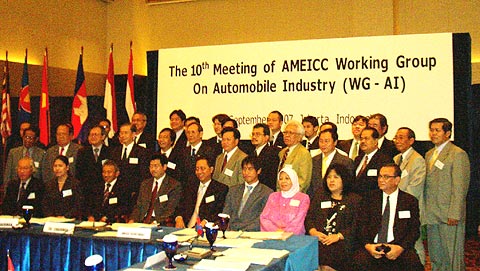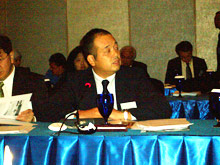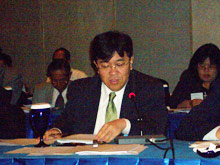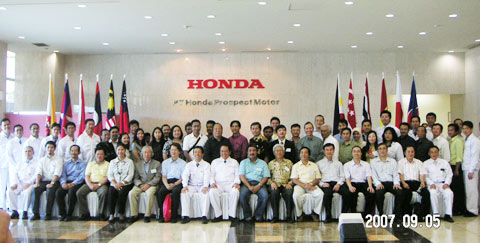*Outline of the Meeting
1. Date:
4-5 September 2007
2. Venue:
Gran Melia Hotel, Jakarta, Indonesia
3. Participating countries:
Cambodia, Indonesia, Laos, Malaysia, Myanmar, Philippines, Singapore, Thailand, Vietnam, ASEAN Secretariat, Japan
4. Japanese participants:
Mr. Hashimoto, Director, Mr. Nigauri, Assistant Director, Automotive Policy Planning, METI
Mr. Matsushima, Section Assistant Director, Technical Cooperation Division, METI
Mr. Iwatake, Vice president, Mr. Oka, Group Leader, International Affairs, JAMA
Mr. Nakamura, Director General, Mr. Guan, Asia Office, JAMA
Mr. Hattori, Toyota Motor Corporation (sent by JAMA)
Mr. Saegusa, Nissan Motor Co., Ltd. (sent by JAMA)
Mr. Nakagawa, Mr. Yoshizawa, and Ms. Yabe, Honda Motor Co., Ltd. (sent by JAMA)
Ms. Hirota, JARI
Officials from JODC Bangkok, JICA and JETRO
Tsujimura, JASIC
5. Outcome:
I attended the AMEICC-AI meeting with the referral of the Ministry of Land, Infrastructure and Transport and made a presentation on long-term efforts for building the foundation for mutual recognition of vehicle certification systems based on the ECE regulations. Also, JAMA made a presentation to propose the establishment of vehicle certification system in each ASEAN country by 2010. Thus, Japan sought for understanding on the vehicle certification system and the mutual recognition thereof through the two relevant presentations.
Although there were questions and comments on associated matters, no comment was made in particular about the vehicle certification system or the mutual recognition system themselves during the meeting.
6. Comments:
Through discussions with the government and industry officials outside the conference room, I felt that it was necessary to promote the understanding of the other countries on the benefits that the establishment of the certification system and the adoption of the ECE regulations will help maintain uniform quality and block the inflow of inferior products, leading to the promotion of the development of industries with excellent track records within each country.
Since understanding of the industrial ministries is also essential in facilitating each country’s participation in the 1958 Agreement and the establishment of the international vehicle certification system in future, it is important to obtain an adequate understanding by continuously providing explanations to them.
Lastly, I would like to extend my gratitude to the Ministry of Economy, Trade and Industry and the Ministry of Land, Infrastructure and Transport for having given me the valuable opportunity.
*Other discussions
1. Overall report on the activities of AMEICC-AI (Secretariat)
Four main pillars of the activities were given as follows: 1) Enhancement of distribution and capital within ASEAN, 2) Support to the development of the ASEAN automobile industry, 3) Cooperation for the development of the automobile industry in the CLMV countries and 4) Facilitation of the development of motorization.
2. Annual report by each country
Production and sales volumes of automobiles in the ASEAN countries in 2006 remained the same as or declined from the previous year.
Indonesia, Philippines and Thailand commented on the efforts for the introduction of the ECE regulations while referring to their major activity policies, but there was no new information in particular.
METI proposed substitution to next generation fuel-powered vehicles as well as reducing oil dependency from 100% to 80% and increasing energy efficiency by 30% in the transportation sector by 2030.
3. Automobile certification and mutual recognition
(a) Report on the activities of AAF/ TC3 (Mr. Bambang, AAF)
Mr. Bambang reported on the status of fuel improvement and harmonization of automotive emission standards at the WG1, establishment of the type certification system in the WG2 and the introduction of the ECE regulations in the WG3. Also, he showed objection to the idea of establishing an ASEAN’s original approval mark. TC5 showed a policy of introducing the ECE regulations of motorcycles.
(b) Establishment of the vehicle certification system (Mr. Yoshizawa, JAMA)
Mr. Yoshizawa proposed an action plan for the establishment of the vehicle certification system in each ASEAN country based on the ECE regulations by 2010.
(c) Mutual recognition of vehicle certification (Tsujimura, JASIC)
I gave an outline of the mutual recognition system of vehicle certifications based on the ECE regulations and efforts for the establishment of the system. I also discussed major matters to be studied and asked each country for comments on the issues relating to the participation in the 1958 Agreement.
Questions and answers on (b) and (c)
Q.The ACCSQ is currently discussing the MRA on automobiles. May I suggest explaining the MR based on the 1958 Agreement to the ACCSQ? (Cambodia)
A.We have already explained the MRA on automobiles at the ACCSQ-APWG.
Q.Since it took 20 years even for Japan to participate in the 1958 Agreement, participation in the 1958 Agreement is a very challenging target for the ASEAN countries. (Malaysia)
A.It took many years to revise the 1958 Agreement to an agreement applicable to the whole world. Japan participated in the Agreement immediately after the revision. Therefore, it is wrong to consider that 20 years were required for Japan to participate in the Agreement.
Q.Considering that the agreement under the WP29 does not include the MRA on the vehicle certification system, isn’t it impossible to reach the MRA of the vehicle certification system in each ASEAN country based on the UNECE regulations by 2010? (Malaysia)
A.JAMA is proposing the establishment of the vehicle certification system and development of technical requirements utilizing the UNECE regulations in each country by 2010.
Q.We have problems in terms of human resources, facilities and funds to adopt the ECE regulations. What assistance can we expect from Japan? (Malaysia)
A.We understand that there are problems in general, but the Japanese government is unable to provide assistance unless problems are specified. You should clearly define what problems you have.
(Malaysia) Please let us continue discussing this issue with METI.
4. Fuel property and automotive emission
(a) Improved atmospheric environment (Mr. Hirota, JARI)
Mr. Hirota showed data on worsening air pollution caused by the rapid development of motorization in ASEAN and presented a concept on the introduction of automotive emission control based on the data.
(b) Automobile technology and fuel quality for the improvement of the environment (Mr. Saegusa, JAMA)
Mr. Saegusa explained the relationship between automotive emission control and fuel property.
*JASIC mentioned that fuel property is a matter of international concern and that a round table discussion will be held on it at the WP29 of the United Nations in November 2007.
5. Partnership enabling highly competitive international transportation (Mr. Nigauri, Section Manager, Automobile Division, METI)
Mr. Nigauri made a presentation on the progress of researches on efficient land transportation routes within ASEAN and latest techniques of efficient logistics using the RFID, etc.
|







